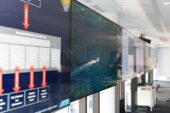A EU research project is testing the combination of different surveillance technologies on refugees. This involves telephone and motion detectors, cameras, radar systems, electromagnetic sensors as well as eavesdropping microphones. In addition to drones, “stratospheric platforms” will also be used.
On its research website, the EU Commission states that “irregular migration has dramatically increased, and is no longer manageable with existing systems”. This is why the Commission wants to improve the detection of undocumented border crossings with new technology. The focus is on densely wooded land borders, which are difficult to monitor with patrols. The security research project is entitled “Through-foliage detection, including in the outermost regions of the EU” (FOLDOUT) and is led by the Austrian Institute of Technology. Among those involved are the French armaments group Thales and border police forces from Bulgaria, Finland, Lithuania and Poland.
Border sections will initially be monitored using conventional systems, including cameras, acoustic or motion detectors. Suspicious car traffic, for example, could first be detected. The authorities also want to take advantage of the mobile phones carried by refugees. If a telephone is detected in a certain radio cell, the device is located.
Geostationary observation from altitudes of 20 kilometres
A cascade of further measures can then be initiated, including observations from space and from the air. Radar satellites, whose images can penetrate leaves, will also be used. If people are located, they can be tracked down with drones. The unmanned aerial vehicles can also carry small radar sensors or thermal imaging cameras. At the end the access is made by the responsible border police.
FOLDOUT could also be used for permanent surveillance of a particular region. The surveillance technology would be mounted on “stratospheric platforms” such as those currently being developed by some armament companies. The geostationary systems fly at an altitude of around 20 kilometres and therefore offer a significantly higher resolution than Earth observation via satellite. The Thales Group, which is involved in FOLDOUT, markets such a system under the name “Stratobus”.
Focus on EU external border with Turkey
The security research project is to develop a so-called “System of Systems”. All incoming information will be processed and coordinated in a situation centre. According to the project description, the algorithms used will be “based on machine learning”. The technology will help to analyse the information from the sensors according to unusual patterns. FOLDOUT should also work under extreme weather conditions, tests are carried out at temperatures between 40 degrees plus and 40 degrees minus.
The research lasts 42 months and is funded under the EU’s “Horizon 2020” research framework programme. The total budget of over eight million euros will be taken over by the Commission. The focus is on the EU’s external border with Turkey, with a two-year work package devoted solely to observing border regions in Bulgaria.
Last week, the outgoing EU Home Affairs Commissioner Dimitris Avramopoulos announced the timetable for testing the digital defoliation. At the beginning of 2021, trials will take place on the Bulgarian-Turkish border, and a few months later FOLDOUT will be piloted on the Greek-Turkish border river Evros. Further tests will be carried out at the Finnish EU external border and in the rainforest of French Guiana.
Image: Test at Greek land border with Turkey (YouTube).




